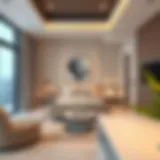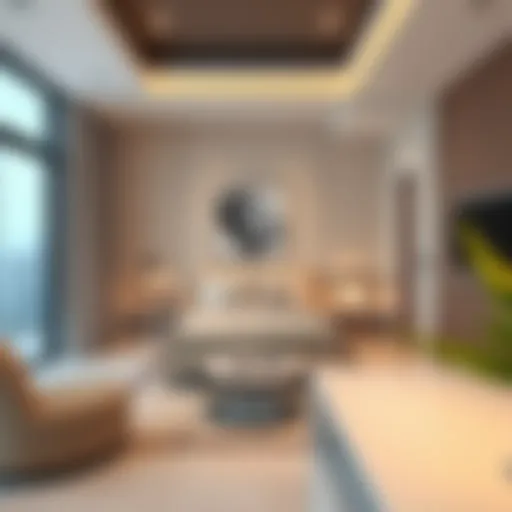Innovative Small Arabic House Designs for Modern Living
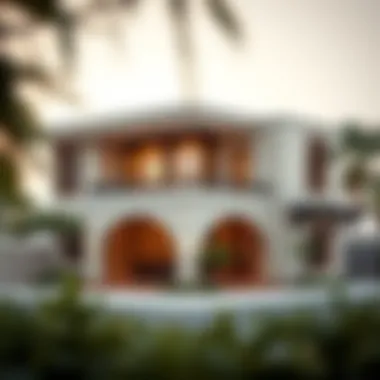

Intro
In the dense tapestry of urban life, especially in vibrant regions like Dubai, the architecture of small Arabic houses stands out as a significant design language. This isn’t merely about aesthetics or functionality; it intertwines culture and tradition in a space often limited in size yet brimming with character. The significance of understanding these designs stretches beyond mere appreciation; it speaks to potential homeowners, architects, and investors who aspire to integrate traditional elements into modern settings.
As spaces grow tighter in bustling metropolises, how small Arabic houses manage to showcase comfort while paying homage to their cultural roots becomes a focal point of discussion. The traditional designs are not just relics of the past; rather, they provide valuable lessons in efficiency and sustainability that can adapt to current challenges in housing markets.
The upcoming sections will explore market trends that shape the demand for small Arabic houses today and forecast what might lie ahead. We’ll also delve into investment strategies, outlining the types of properties that are becoming increasingly popular among diverse investors. Navigating through these elements will curate a comprehensive understanding of how Arabic house design can not only reflect a rich heritage but also respond to and thrive within contemporary lifestyles.
Prelude to Arabic House Design
Arabic house design embodies centuries of rich architectural heritage and cultural expression. As cities evolve, particularly in bustling regions such as Dubai, understanding traditional Arabic housing principles takes on new importance. Not only does this design philosophy offer aesthetic appeal, but it also provides practical solutions for small living spaces. These houses often reflect a deep connection to nature, community, and tradition, making them a fascinating subject for homeowners, architects, and real estate investors alike.
Historical Context
The historical context of Arabic house design is deeply intertwined with the climatic and cultural attributes of the region. Dating back to ancient times, early homes in the Arabian Peninsula were built with local materials like clay, stone, and palm fronds. The harsh climates, where temperatures could soar during the day, significantly influenced these designs. Houses often featured thick walls for insulation and small windows to keep out heat, showcasing the ingenuity of early inhabitants.
As cities grew, so did the complexity of the architecture. With influences from various cultures—Persian, Indian, and Mediterranean—Arabic homes began to incorporate elaborate courtyards, canopies, and geometric patterns that are still visible in modern designs. These adaptations not only present a visual feast but also tell a story of resilience and adaptation, keeping the essence of Arabian culture alive through generations.
Cultural Significance
The cultural significance of small Arabic house design cannot be overstated. Homes are not merely structures; they serve as a sanctuary for families, reflecting traditions, values, and social structures. In many Arabian cultures, the home is not just a personal space but a gathering place where hospitality reigns supreme. The design encourages communal living—courtyards are often central to the layout, promoting both privacy and togetherness.
Furthermore, the architectural style often emphasizes symbolism, which can be seen in the choice of patterns and colors. Each element tells its own story—like the intricate mashrabiya screens that offer privacy while allowing cool breezes to flow through.
According to some sources, traditional Arabic architecture is a vital part of the community’s identity, a characteristic preserved even as some homes transition to modern interpretations. The essence of family and community remains entwined in these structures, where every corner holds memories and traditional narratives from generations past.
"A house isn’t just built; it’s crafted from the very essence of history and culture. In Arabia, the walls whisper tales of warmth and togetherness.”
By delving into the depths of Arabic design, we not only appreciate the beauty of these homes but also gain insight into a culture that has persistently balanced tradition with modern necessities. This duality becomes crucial as we explore the core principles of small Arabic house design in the following sections.
Core Principles of Small Arabic House Design
Understanding the core principles behind small Arabic house design is akin to appreciating a beautifully woven carpet—each thread plays a crucial role in the overall tapestry. Focusing on elements like spatial efficiency, natural ventilation, and indoor-outdoor harmony, these principles not only cater to aesthetic values but also address practical living needs, especially relevant in urban settings like Dubai.
Spatial Efficiency
In the realm of small Arabic homes, spatial efficiency emerges as a critical design tenet. The layout must ensure maximum utilization of limited square footage without compromising comfort. Architects often employ open floor plans that connect living areas seamlessly, making homes feel larger than they are. Common features include:
- Multi-functional spaces: Rooms serve various purposes, such as a living room that can transform into a guest space.
- Built-in furniture: Couches with storage or foldable tables increase functionality while saving space.
- Vertical designs: Utilizing height, with tall shelves or lofted beds, allows residents to maximize usable space.
By emphasizing spatial efficiency, small Arabic houses can feel inviting, even when they occupy a modest footprint. This is particularly advantageous for expats and local families who seek comfortable yet practical living options in the bustling real estate market.
Natural Ventilation
An often-overlooked aspect of modern design is natural ventilation, which is essential in creating comfortable interiors in hot climates. Small Arabic homes typically incorporate elements such as open windows, high ceilings, and strategically placed ventilation shafts. These designs do more than keep spaces cool; they can drastically decrease the reliance on artificial cooling methods, making homes more sustainable. Key benefits include:
- Improved air quality: Fresh air circulation helps reduce indoor pollutants.
- Energy savings: Reducing the need for air conditioning lowers utility bills.
- Healthy living: Proper ventilation can prevent issues like mold and stale smells, promoting a better quality of life.
Thus, embracing natural ventilation is not merely about comfort; it's a step towards sustainable living that resonates with environmentally-conscious homeowners and renters.
Indoor-Outdoor Harmony
Creating a sense of indoor-outdoor harmony is fundamental in Arabic house design. This approach merges the coziness of home with the expansive beauty of nature. Most small Arabic houses feature large, welcoming doors, terraces, or even courtyards that invite the outside in. Key considerations in achieving this balance include:
- Landscaping: Thoughtfully planned gardens enhance curb appeal and provide a tranquil escape.
- Materials: The use of natural materials like stone and wood can blur the lines between indoor spaces and nature.
- Natural light: Strategic window placement allows natural sunlight to flood the interior, creating warm, inviting atmospheres.
This harmonious relationship fosters a serene atmosphere, allowing residents to enjoy their surroundings whether they are indoors or lounging outside.
"The best part of architecture is that it comes alive in the interactions between people and built environments."
In summary, the core principles of small Arabic house design present a blueprint for revolutionary living spaces that marry aesthetic appeal with functional requirements. For investors, agents, and buyers, an appreciation for these principles could unlock valuable insights into making smart property decisions that echo the changing landscape of Dubai's real estate.
Through mixing tradition and modernity, these principles not only sustain cultural heritage but actively contribute to the future of architectural innovation in the region.
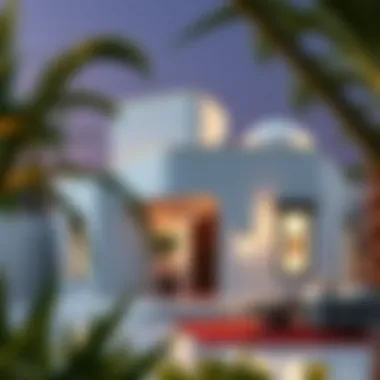

Architectural Elements Unique to Arabic Homes
The architectural elements that define Arabic homes are not just decoration; they are woven deeply into the very fabric of the culture’s identity. This section explores elements like arches, domes, courtyards, and mashrabiya screens, emphasizing their functional and aesthetic significance in small Arabic house design. These features serve various purposes, from climate adaptation to enhancing the home's beauty and cultural resonance.
Arches and Domes
Arches and domes are perhaps the most iconic symbols of Arabic architecture, lending these homes a sense of grandeur and tranquility. The beauty of arches lies not only in their curvature but also in their ability to redistribute weight efficiently. This means that in a small house, adding an arch can create an illusion of space while maintaining structural integrity. Furthermore, domes serve a vital function in promoting air circulation within the home. The elevated ceiling created by a dome allows hot air to rise, effectively cooling the living areas below.
- Functionality: The use of arches and domes contributes to better airflow and a cooler indoor environment, which is essential in hot climates. Their design often reflects the organic shapes found in nature, creating harmony with the surroundings.
- Aesthetic Appeal: Not only are they practical, but they also offer a unique aesthetic, often adorned with intricate tile work or plaster carvings, which celebrate local artisanship. Imagine walking through a hallway under an arch, where light filters through its form, casting beautiful shadows.
Courtyards
Courtyards are a hallmark of small Arabic homes, offering private outdoor space that blurs the line between the inside and outside. In many designs, these areas serve as a central gathering spot for family and friends, facilitating social interaction while providing a serene escape from the heat.
- Cultural Relevance: The courtyard is deeply embedded in social practices; it allows for gatherings while preserving the privacy that is valued in Arabic culture. Families can enjoy fresh air, the scent of local flowers, or even a small fountain that adds to the ambiance.
- Environmental Benefits: From an environmental perspective, courtyards enhance ventilation, allowing cool breezes to flow through the home. They can also be designed to capture rainwater, a precious resource, reflecting the sustainable practices that are increasingly relevant in modern architecture.
Mashrabiya Screens
Mashrabiya is a distinctive feature that brings both style and function to Arabic homes. These wooden lattice screens not only provide shade and cooling but also serve as a means of privacy without blocking views or natural light.
- Ventilation and Light: The intricate design allows for air circulation while filtering sunlight in a way that creates a soft glow inside the home. The patterns often carry significant cultural motifs, enhancing the aesthetic experience of a room.
- Cultural Significance: Using mashrabiya is a nod to tradition, harkening back to times when privacy was paramount in urban areas. It also provides a connection to the past, showcasing craftsmanship that has been passed through generations.
The architectural elements unique to Arabic homes are not merely functional aspects; they embody the very essence of cultural identity, marrying form and function in a timeless dance.
Incorporating these elements into modern small Arabic house designs not only preserves tradition but also enhances the living experience. As such, they offer an essential foundation for any investor or homeowner seeking to embrace the rich heritage of Arabic architecture while navigating contemporary needs.
To learn more about the significance of these designs, you can explore additional insights on Wikipedia or visit Britannica.
By thoughtfully integrating these architectural features, potential homeowners can create spaces that are not only functional but rich in historical significance, ensuring their homes echo the past while looking toward the future.
Contemporary Adaptations of Traditional Designs
The essence of contemporary adaptations in traditional Arabic house designs provides a fascinating lens into the evolution of architecture while preserving cultural integrity. As modern living demands shift and urban spaces become ever more congested, the practice of adapting time-honored design elements becomes crucial. This understanding allows architects to balance traditional aesthetics with the requirements of modern lifestyle and urban environmental pressures, particularly in dynamic markets like Dubai.
Modern Materials and Techniques
In recent years, the caliber of materials used in small Arabic homes has advanced significantly. Innovative materials such as reinforced concrete, glass, and steel are now being favored. This choice not only enhances durability but also infuses a sense of contemporary style while adhering to traditional silhouettes. For instance, large glazing panels can allow natural light to fill living spaces, an element reminiscent of traditional courtyards but with a modern twist.
One of the most compelling aspects of using modern materials is the efficiency and effectiveness they bring to building methods. Prefabricated elements, which might resemble traditional arches, can be manufactured off-site and swiftly assembled, reducing labor costs and time. Such techniques also reflect sustainability principles, allowing builders to minimize waste.
"Adopting contemporary materials doesn’t just modernize a space; it’s about honoring the past while paving the way for innovative futures in architecture."
Sustainable Practices
With global concerns regarding environmental impacts, sustainable practices in Arabic house design have emerged as not just an option but a necessity. Incorporating green technologies such as solar panels, rainwater harvesting systems, and natural insulation methods can elevate the energy efficiency of small homes. These practices echo the traditional reliance on nature's resources, akin to the use of thick walls and small windows designed to keep interiors cool in the blazing desert sun.
In addition, new landscape practices promote biodiversity and encourage native plants that require minimal maintenance. This ties in closely with environmental consciousness—having a home doesn’t mean having to forego nature, but rather finding harmony with it.
Ultimately, understanding the adaptation of Arabic house designs isn't just about reshaping buildings; it’s a form of cultural dialogue. It reflects a commitment to both heritage and progress, merging the wisdom of the past with the innovations of the present while considering the demands of the urban environment. Investors and homeowners alike should take note of how these trends pave the way for more livable and sustainable communities.
Designing for Climate: Challenges and Solutions
The climatic conditions in Arabian regions present a unique set of challenges and opportunities for architects and homeowners alike. In crafting small Arabic houses, designers must consider heat management and water use, both paramount in ensuring comfort and sustainability. These considerations not only help maintain livable conditions but also contribute to long-term energy efficiency and resource conservation.
Heat and Insulation
Heat management is a central issue in Arabic house design, especially in places like Dubai, where temperatures can soar during the summer months. Traditional Arabic houses were designed with thick walls and small windows to minimize heat gain, but modern approaches have integrated new techniques to enhance performance.
- Insulation Materials: Modern insulation options, such as mineral wool and cellulose, not only provide effective thermal resistance but are also eco-friendly. Integrating these materials within the walls keeps the interior temperature comfortably cool. Using lightweight concrete can also improve heat resistance without adding unnecessary weight to the structure.
- Architectural features: Incorporating features like high ceilings and spacious courtyards helps to circulate air naturally. Additionally, designing overhangs that shade windows from direct sunlight is a traditional yet crucial practice. These elements work together to reduce reliance on mechanical cooling systems, leading to energy savings and reduced environmental impact.
"Investing in heat management strategies today will prepare homes for tomorrow’s climate challenges, making them resilient and sustainable."
- Technology Integration: Incorporating smart home technology can also enhance heat management. Sensors can be employed to adjust window shades based on sunlight, optimizing indoor temperatures automatically.
Water Management
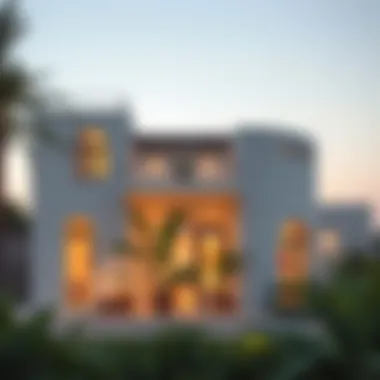

In arid environments, water is a valuable commodity, making efficient management crucial in house design. With the trend pushing towards sustainability, the integration of water management systems in small Arabic homes is more relevant than ever.
- Rainwater Harvesting: A practical solution involves setting up systems to collect and store rainwater. This not only reduces reliance on municipal water supply but also allows homeowners to irrigate gardens or perform other household tasks without incurring hefty water bills. Designing roofs to channel water into cisterns is a valuable addition.
- Greywater Recycling: Another innovative concept is the use of greywater systems that repurpose water from sinks and showers for irrigation. Employing strategic plumbing configurations can help achieve this, making it easier for homeowners to sustain their gardens while conserving drinking water.
- Native Landscaping: Choosing drought-resistant plants for landscaping minimizes water usage. Integrating local flora not only flourishes in the environment but also requires significantly less maintenance.
In summary, adapting small Arabic houses to meet climatic challenges is imperative for future sustainability. By focusing on heat management and water use, homeowners and designers can create spaces that remain cool during scorching summers while efficiently managing water to accommodate the region’s needs.
For more information on sustainable architectural practices, explore Wikipedia and Britannica.
- Explore more about local flora and landscaping at Reddit and engage in community discussions.
- For tips on rainwater harvesting, check guides on *.gov websites for local regulations and best practices.
Interior Design Elements in Arabic Homes
Understanding the interior design elements in Arabic homes is crucial, as these features hold both aesthetic and functional significance. They reflect a unique cultural heritage while catering to the practical needs of contemporary living. These design choices not only enhance the beauty of the spaces but also promote a sense of community and connection within them.
Textiles and Patterns
Textiles play a pivotal role in the interior design of Arabic homes. Rich fabrics with intricate patterns not only add color but also carry stories of tradition and craftsmanship. Consider the use of kilims, traditional flatweave carpets often seen in Arab interiors. They serve dual purposes: providing comfort underfoot while showcasing artistry from various regions.
Moreover, the influence of Bedouin and Islamic designs can be seen in textiles that incorporate geometric patterns and floral motifs. Upholstery, curtains, and cushions fashioned from these materials can transform a space, making it vibrant and inviting. Here are several key points about textiles and patterns:
- Layering: Combining different textiles can create a sense of depth and warmth in a room.
- Cultural Symbolism: Many patterns carry significant meanings. For instance, arabesques signify eternity and continuity.
- Textile Texture: The combination of textures, like plush velvet with coarse linen, adds visual interest and tactile engagement.
Color Schemes
Color schemes in Arabic homes often reflect the local landscape and cultural influences. The palettes range from earthy browns and ochres to vibrant blues and deep greens, mirroring the region’s natural beauty. This diversity in colors can evoke varied moods and atmospheres. For instance, a soft palette might instill tranquility while vibrant hues may energize the space.
The strategic use of colors can also influence the perception of space. Lighter shades tend to make rooms feel larger, while darker tones can create a cozy nook. A common practice is to use bold accent colors on one wall, often accompanied by neutral shades in the remaining areas.
Some important considerations regarding color schemes include:
- Local Influence: Colors often derived from local materials, such as clay and stone, resonate with architectural styles.
- Natural Light: The amount of natural light a room receives should guide color choices. Rooms with limited daylight benefit from lighter, warmer tones.
- Cultural Significance: Colors, such as green, are often associated with prosperity and fertility in Arab cultures.
"The harmony of textiles and colors in Arabic homes fosters a welcoming atmosphere while preserving deep-rooted cultural connections."
Influence of Modern Technology on Design
The realm of architecture consistently transforms, adapting to the ever-changing landscape of technology. In the context of small Arabic house design, incorporating modern technology not only enhances functionality but also aligns with contemporary needs. It nurtures a seamless blend of tradition and modernity, promising efficiency while respecting cultural heritage. By synergizing traditional aesthetics with cutting-edge advancements, the designs can speak to a broader audience, appealing to homeowners, architects, and investors alike.
Smart Home Features
Smart home technology has become a pivotal element in modern design. These features catapult small Arabic houses into the future, promoting convenience and security. Homeowners can control various systems through mobile apps or voice commands, bridging inhabitants with their living spaces. Some key components include:
- Automated Lighting: Lighting can adjust according to the time of day, helping to save energy while also creating a warm ambiance akin to traditional Arabic courtyards.
- Smart Thermostats: These devices regulate temperature based on occupants’ habits, enhancing comfort without excessive energy consumption, which is crucial in hot climates.
- Security Cameras: Video monitoring offers peace of mind, allowing residents to keep a watchful eye, integrating seamlessly with the home's aesthetic.
Investors in Dubai's real estate market should consider how these features not only attract prospective renters but also significantly add to the property’s value. Potential homeowners stand to benefit from these systems that enhance their lifestyle without compromising their cultural roots.
Energy Efficiency
Energy efficiency stands as a cornerstone in the design of small Arabic houses, especially within a climate characterized by soaring temperatures. Traditional constructions offered solutions like thick walls for insulation and strategic window placements for natural ventilation. However, modern advancements enable even more potent designs. Some considerations include:
- Solar Panels: Harnessing the sun's energy is not just environmentally friendly but also cost-effective in the long run. Integrating solar panels into roof designs can significantly reduce electricity bills and promote self-sufficiency.
- High-Performance Insulation: Utilizing advanced materials for insulation can minimize heat transfer, ensuring that the indoor environment remains comfortable.
- Energy-Efficient Appliances: Employing appliances rated for energy efficiency reduces overall consumption, promoting sustainable living practices.
Consideration of energy efficiency not only lowers operational costs but also fulfills a growing demand for sustainable living, marking a key focus in today’s architectural design.
As we stride into an era dominated by technology, the implications for small Arabic house designs are vast. Investors and homeowners alike should remain attuned to these advancements, understanding their significance in elevating architectural practices while preserving cultural aesthetics.
Case Studies of Notable Small Arabic Houses
Understanding the design and function of small Arabic houses can be effectively complemented by examining specific case studies. These examples serve as tangible illustrations of architectural philosophies that have evolved and adapted over time. By exploring both traditional and contemporary interpretations, potential homeowners, investors, and architects can glean valuable insights into the nuances of architectural choices that either reflect cultural heritage or embrace modern sensibilities.
Traditional Examples
The architectural legacy of small Arabic houses is rich and varied. Traditional examples offer a glimpse into a way of life that harmoniously intertwines form with function.
A noteworthy case is the traditional courtyard house, often found in the heart of cities like Fez, Morocco. These homes utilize internal spaces for privacy and protection from harsh external climates. The courtyard, typically filled with greenery, serves as a private oasis where family life unfolds openly yet away from public scrutiny. The rooms surrounding the courtyard are often small but thoughtfully arranged to enhance social interactions, emphasizing communal living.
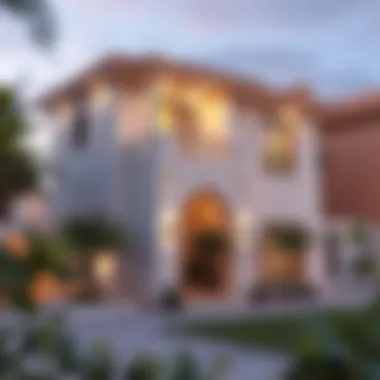

Moreover, the use of wind catchers, or malqaf, showcases ingenious climate-responsive design. These structures capture cooler breezes from above, directing them into living spaces—an idea that, while ancient, remains relevant in discussions about natural ventilation today.
Another impressive example can be seen in the buildings of the old city of Jeddah. These homes, made predominantly of coral stone and treated with intricate wooden mashrabiya screens, not only reflect the aesthetic value but also illustrate environmental adaptability. Functioning as both sun shades and aesthetic features, these screens allow for views while keeping interiors cool—a design principle still valid in modern contexts.
Contemporary Interpretations
The juxtaposition of tradition and modernity paints a vibrant picture of today’s small Arabic house designs. Recent projects highlight an effort to forge connections with historical roots while accommodating contemporary lifestyles.
Consider, for instance, contemporary homes designed by architects like Zaha Hadid, where traditional Arabic elements are reshaped using modern materials and methods. A prime example is the use of prefabricated panels that mimic the traditional mashrabiya but are made of lightweight materials, resulting in visually stunning and innovative structures. This blend not only maintains cultural identity but also addresses the challenges of urban living in sprawling cities like Dubai.
Additionally, the concept of compact living units is gaining traction. Architects are increasingly designing small homes that maximize space without compromising on aesthetics. Features often include multi-functional furniture and open-plan layouts that blur the lines between indoors and outdoors. These designs adapt classic principles, such as using shaded terraces, to modern needs for sustainable living.
In summary, case studies of notable small Arabic houses illuminate the diverse approaches to integrating tradition into contemporary society. Whether through the adaptation of historical techniques or the pursuit of innovative solutions, these examples not only enhance our understanding of architectural heritage but also encourage a thoughtful dialogue on sustainability and cultural identity within Dubai's evolving real estate landscape.
Implications for Dubai's Real Estate Market
The evolution of small Arabic house design carries significant implications for Dubai's real estate market. As urban landscapes continue to transform, understanding the interplay between traditional architecture and modern real estate dynamics becomes crucial. This section delves into the myriad ways in which these designs can influence property investment, attract diverse demographics, and contribute to sustainable urban development in one of the world's most rapidly changing cities.
Investment Potentials
The small Arabic house design presents various investment potentials within Dubai's bustling real estate sector. Properties that blend traditional aesthetics with modern conveniences are increasingly sought after, attracting both local and expatriate buyers. Here are some salient points to consider:
- Cultural Appeal: Investors are honing in on homes that resonate with the cultural backdrop of Dubai. The charm of small Arabic houses, with their courtyards and intricate details, appeals to those who value heritage.
- High Demand for Spacious Living: Despite the trend towards vertical living, the demand for smaller, more intimate homes with efficient use of space remains strong. Such designs allow families to maximize their footprint without compromising on lifestyle.
- Sustainability Incentives: Investment in properties that incorporate sustainable practices and energy-efficient designs can offer financial incentives. Government programs often support green initiatives, attracting financially savvy investors.
In short, the investment landscape is transforming, as more individuals seek out properties that reflect both their own values and the cultural context of their surroundings.
Market Trends in Architectural Design
Understanding the market trends in architectural design is essential to grasp the full scope of the implications of small Arabic house design in Dubai. The following trends are shaping the future of housing in the emirate:
- Fusion of Styles: There is a marked interest in homes that seamlessly blend traditional Arabic aesthetics with contemporary architectural elements. This synthesis not only appeals to various demographics but also embodies the city's spirit of innovation.
- Emphasis on Community Living: Developers are increasingly incorporating community-centric designs, with shared spaces and gardens fostering a sense of belonging among residents. Small Arabic house designs often excel in this regard, offering communal elements while maintaining individual privacy.
- Smart Integration: The rise of technology in home construction is evident. From energy-efficient designs to smart home features, the integration of modern technology into traditional styles is becoming standard. This attracts tech-savvy buyers looking for modern conveniences that do not overshadow cultural integrity.
- Regulatory Frameworks: Policies from the Dubai government promoting sustainable living and preserving the architectural heritage are influencing market trends. Investors must stay attuned to these regulations as they navigate the evolving landscape.
In summary, staying informed about market trends regarding small Arabic house design can provide investors and homeowners with a competitive edge. It allows them to align their investments with consumer preferences and government initiatives, thereby securing both financial and emotional returns on their property investments.
Investing in properties that celebrate cultural heritage while embracing modernity allows for not just financial gains, but also a sense of belonging in a fast-paced world.
As the real estate market continues to evolve, the implications of small Arabic house design will remain at the forefront, shaping the future landscape of living in Dubai.
For further details on architecture trends and investments, you may visit Wikipedia or check out insights on Britannica.
Future Directions in Arabic House Design
The topic of future directions in Arabic house design is crucial as it outlines how traditional aesthetics can intertwine with global trends in architecture. The need for homes that are not only visually appealing but also functional and sustainable is increasingly gaining traction among homeowners, investors, and architects alike. By emphasizing innovation while respecting cultural heritage, the future of Arabic house design offers a vibrant synergy of modern demands and historical elements.
Integration with Global Styles
In an era marked by globalization, small Arabic houses are evolving to incorporate aspects of global architectural styles. This integration does not necessarily mean abandoning tradition; rather, it signifies a blending of ideas that enrich the overall design.
For instance, minimalism—popular in many Western designs—is finding its way into Arabic houses, allowing for cleaner lines and less clutter while maintaining an aura of sophistication. Large windows, akin to those seen in modern Scandinavian homes, are being used to encourage natural light and connect indoor spaces with the outdoor environment.
This fusion creates a unique identity, appealing to both local residents and expatriates looking for a home that resonates with their lifestyle. Here’s why this integration is significant:
- Broader Market Appeal: By combining traditional and international styles, these homes become attractive to a wider demographic, including young professionals and families.
- Architectural Dialogue: The conversation between different styles fosters a richer architectural narrative, celebrating diversity and creativity.
- Functional Benefits: Many global design concepts focus on maximizing space and efficiency, which can greatly enhance the livability of smaller homes.
"Design is not just what it looks like and feels like. Design is how it works." - Steve Jobs
Strategies for Integration:
- Use of contemporary materials like steel and glass alongside traditional ones such as clay and wood.
- Drawing upon international trends in open-plan layouts to make homes feel more spacious.
- Incorporating greenery in the design, merging indoor and outdoor spaces while improving air quality.
Cultural Preservation vs. Modernization
Balancing cultural preservation with modernization is another challenge faced by small Arabic house designs. While new methods and designs cater to changing lifestyles, the essence of Arabic architecture must be kept alive to maintain its cultural significance.
The key is to find a middle ground where cultural symbols are embraced, but also allow for modern conveniences. Essential architectural elements like courtyards and arches can be preserved, even when modern amenities are introduced. Here are some considerations:
- Respect Tradition: Homeowners can choose to maintain traditional features while integrating modern updates. This approach honors the past while adapting to contemporary needs.
- Community Involvement: Engaging local artisans and craftsmen in the building process helps ensure that traditional techniques and motifs are incorporated into new designs.
- Adaptive Reuse: Old structures can be repurposed for modern uses without losing their historical charm. This not only saves resources but also retains the stories attached to these spaces.
By navigating these issues thoughtfully, Arabic house design can continue to evolve while keeping its rich heritage in view. This ongoing dialogue between the past and the present is central to the identity of these homes and the communities they inhabit. Addressing these themes effectively will also shape how future generations appreciate and interact with their living spaces.
Ultimately, the future directions in Arabic house design promise not just to craft beautiful homes, but also to foster a lasting connection with culture and environment.


